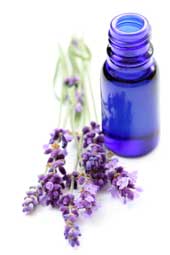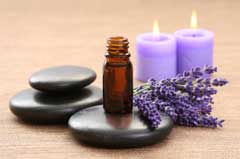Treating Chronic Fatigue Syndrome (ME/CFS) – Part III: Aromatherapy – Using Essential Oils by Vicki Alford
It is Nature herself, in spite of our attempts at “modification” for whatever reason,
who has the privilege of giving us strength for Life, Health and Longevity, and in this, the aromatic oils are our best allies”
Professor Pierre Franchomme / Research Director Laboratory Pranarom
Ways to Use Essential Oils
- Massage using drops of essential oil in a “carrier” oil for massaging hands, feet or all over body massages
- Baths whole body, foot baths, hand baths & sponge baths (3-4 drops of essential oil in a bath)
- Inhalations 3-4 drops in a bowl of boiling water. Bend over so that your face is about 10″ above the water surface & put a large towel over your head & the basin (to keep the steam from escaping).
- Compresses I’ve never tried, but I’m sure they would work as well as any other method.

- Direct application internally & externally (I would not swallow them in case of an allergic response as I’m so perfume/chemical sensitive)
- Ointments follow directions in a good aromatherapy book if you’re interested in making ointments.
- Creams follow directions in a book (or I just put a dollop of vitamin E cream in the palm of my hand & sprinkle a couple of drops of essential oil & stir it in with my finger. My short cut to making a “cream”, works for the few times I want to rub a cream on my arms, knees or hands.
- Water emulsion douches & mouth washes I have never actually tried these.
- Diffusers or oil burners. Sprinkle a few drops on the water (in the well of an oil burner). Light the candle placed in the space under the well.
- Room Sprays I have a small spray bottle filled with undiluted eucalyptus oil (which I use all the time almost daily). I spray on my painful hip & rub in. Much easier to use than tipping a small amount on the palm of your hand, which usually spills on the floor). I spray this in my bathroom (instead of room sprays which make me gag & cough). I spray lightly on the carpet & rub with a clean cloth to remove a stain. I put on a cloth to get the sticky label residue off bottles & jars (that I might re-use for home made chutneys & preserves). Eucalyptus oil gets biro off vinyl or leather magically, without harsh rubbing.
Tips
- Very low dilutions of essential oil have a very therapeutic effect on the mind. Stress and emotional problems seem to respond to a low dilution.
- A higher percentage of essential oil in a remedy, is more effective for treating physical problems such as a bruise or sprained ankle.
Adverse Effects
In general, I would dilute essential oils in a carrier oil before applying direct to my body. I regularly use lavender oil or eucalyptus oil “neat”, as I have tested both, & know them not to cause any adverse reaction. Once again, I stress the importance of testing to ensure no adverse effects both the smell & the actual physical contact should be tested.
If a person finds the smell of any single oil (or combination of oils) repulsive, this reaction can be taken as a sure indication that they should not be used, either for this person or their health condition (even if that same essential oil has been used successfully on another person with the same health condition).
I can eat fresh basil, but had a severe allergic reaction when one of my aromatherapy tutors used basil oil (diluted in a carrier oil) massaged on my back as part of a class demonstration. The tutor very quickly poured the plain carrier oil (almond oil) on my back & towelled it off several times, in order to dilute the essential oil, but it was some time before the burning & red welts completely disappeared.
The strength at which an essential oil is used is very important in aromatherapy. If applied or taken in excess it can have the reverse effect.
When studying aromatherapy I thought to put 7-8 drops of marjoram essential oil in my bath. Marjoram is well known for insomnia. I thought 7-8 drops would be better than 3-4. No so. I had the worst, vivid nightmares of all time. So a few drops sedates & relaxes for insomnia, but twice as much has the opposite effect.
Testing and Purity
Most sellers would have a “tester” open and available for you to smell, or try a drop on your finger (in the store before buying).
- 100% natural just means absence of added synthetic esters & emulsive agents or petrol based dilutents such as mineral oil
- 100% pure should mean the absence of similar essential oils. True lavender is often extended with lavendin.
- 100% complete should mean essences not decolourized or recoloured.
In-Store Testing
- Rub a drop or two between your thumb & index finger. If it feels greasy, it’s probably diluted with vegetable oil.
- Put a drop on plain white blotting paper. Nearly all pure essential oils would evaporate completely, leaving no stain (an exception eg myrrh, which is a thick resin, would not evaporate).
- Put a drop in water. It should float like a tiny drop of oil (and not dissolve). If it dissolves, goes milky or opaque, it probably has emulsifiers mixed with it.
- If it smells alcoholic, it’s probably extended with ethyl alcohol.
People with Environmental Illness/Chemical Injury/MCS
I suggest those with Multiple Chemical Sensitivities smell from the opened “tester” sample bottle first (don’t put your nose too close). If that’s tolerable, put a couple of drops on your inner wrist & walk around for a while (or sit down if you can’t walk for long). If it stills smells ok & has not left a rash or given you any other adverse reaction, then I believe you should be able to tolerate it in a therapeutic application.
Cost
All essential oils are relatively expensive, although prices cover a wide range, depending on percentage yield. But if you consider that you may be using only 1-4 drops at a time, I’m sure you will appreciate that a small 10ml bottle could last quite a long time.
I usually buy a large 50ml bottle of Lavender oil which cost me about Aust$42 (as I use it so much nearly every day) I use it “neat”, mainly for burns (miraculous healing, especially if followed up with regular application of vitamin E cream), & sprinkling on my hot water bottle cover to warm my bed pillow (& then later my feet when I get into bed) in winter. A pillow warmed for an hour or so before bed gives a wonderful night’s sleep (particularly if used regularly every night for several weeks). I’m not saying it cures sleep disorders (like mine), but it certainly helps.
I use this same Lavender oil application on a hot water bottle behind my lumbar back when watching TV (if my lower back pain is bad). When in pain your muscles spasm & tighten, & lavender is an excellent anti-spasmodic.
Personal Statement
I have neither the knowledge nor the experience to “cure” CFS or my own FM. But it only takes an interest, reading & research, to use essential oils & herbs in a supporting role to help ease some of our symptoms.
A microbe is not always the cause of an illness; normally it simply bears witness to a deficiency in the organism under attack. The microbe is far less important that the site.
Why are many CFS sufferers found to have multiple viruses, and healthy people living or working with them do not? If we were to give those with clinically diagnosed CFS/FM the best fresh organic diet, filtered water, fresh un-polluted air, adequate regular rest periods & deep restorative sleep, together with supporting therapies & herbs to restore their immune system & cleanse the toxins which may have accumulated in their bodies, would it be possible for their bodies to heal themselves?
It is perhaps a fanciful imagination to suggest such a simplistic idea? CFS (& FM) have complex combinations of symptoms. Every patient is unique in both their degree of symptoms & genetic or predisposition to disease. There are so many factors which come into play environment, stress, diet, lifestyle, genetics & so forth.
But are we giving our bodies the best chance of recovery by assaulting them with a plethora of potentially hazardous drugs?
Resources
There are many modern books on massage and the use of essential oils they may feature massage techniques as well as oils and their therapeutic properties. But I prefer the earlier books written by aromatherapists who have a greater knowledge of the active constituents of each oil & the scientific research behind their use. These earlier practitioners are often qualified medical doctors or alternative therapists with a much deeper knowledge of the human body, diagnosis of disease and treatment.
- Aromatherapy A-Z by Patricia Price is my “bible”or main reference book written in 1988 a good classic. Lists oils (& what they are used to treat), as well as health problems (with the appropriate oils used for these problems). Some good recipes at the back. It’s like a dictionary. You can look up stress or arthritis and find out which essential oils are good for these conditions, or the word lavender (or any other essential) oil by name & find out what health condition they are used for.
- Practical Aromatherapy by Shirley Price (written in 1983 another old book, but still good advice. Some excellent recipes in this book (several of which I have tried & know to work very well) together with reflexology & massage techniques.
- The Practice of Aromatherapy by Jean Valnet, MD (A classic compendium of plant medicines & their healing properties). A medical doctor and practitioner of aromatherapy Jean Valnet is regarded as the father of essential oil therapy and one of it’s foremost authorities. In this classic manual, he provides detailed evidence for the efficacy of plant medicine nature’s most time-honored method for treatment of illness and relief of pain including case histories & formulas. Dr Valnet makes an impassioned plea for curtailing our use of dangerous chemical therapies and antibiotics, offering demonstrable proof of the vital power of plant medicines to prevent and heal disease and strengthen the immune system.
- Aromatherapy for Everyone by Robert Tisserand. Along with Jean Valnet, Tisserand is one of the most well known practitioners of aromatherapy. He teaches and lectures, promotes and encourages scientific research. This book which was first published in 1988 is another classic.
Dig Deeper! Aromatherapy Part I: Introduction / Aromatherapy Part II: Essential Oils for ME/CFS
Vicki Alford is a person with Fibromyalgia who has used aromatherapy and other natural remedies to markedly improve the quality of her life. She lives in Australia.
The Phoenix Rising website is compiled by a layman. It is not a substitute for a physician and is for informational uses only. It does not present complete information on this drug. Please discuss any treatments in these pages with your physician.

